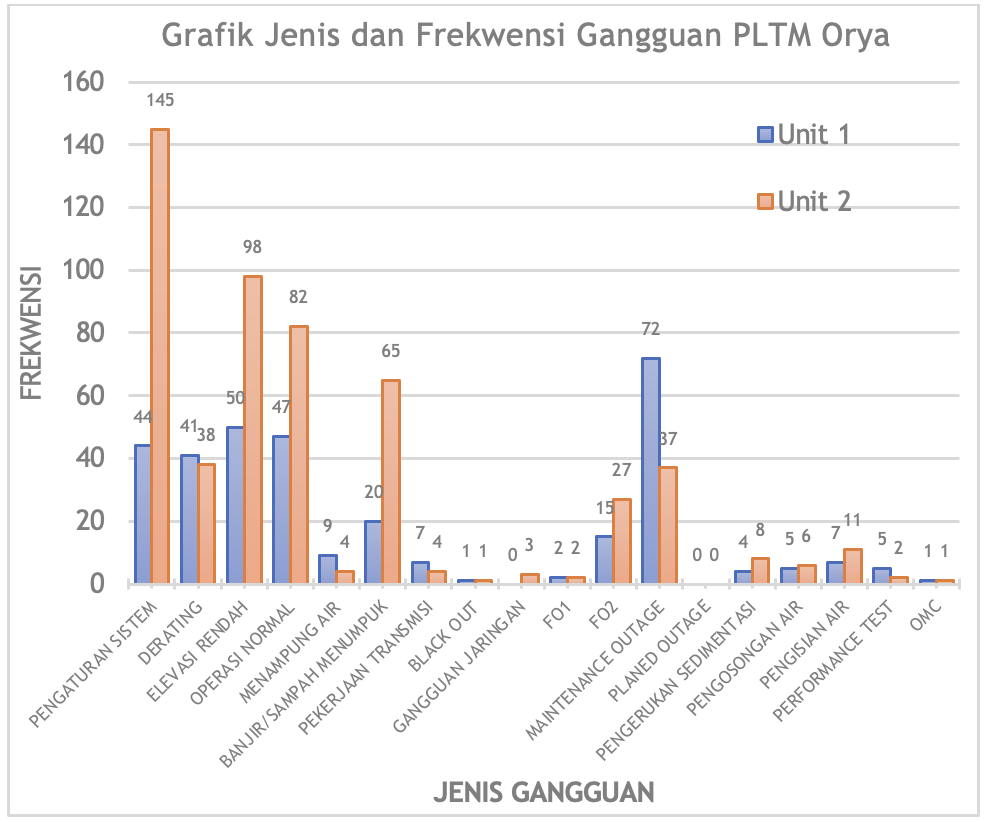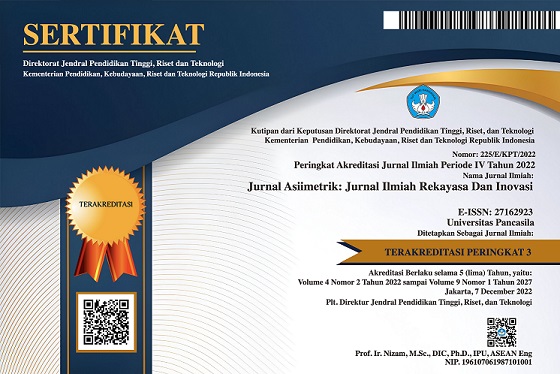Analisis Keandalan Pembangkit Listrik Tenaga Mini Hidro Orya-Genyem Berdasarkan Load of Loss Probability
Reliability Analysis of Orya-Genyem Mini Hydroelectric Power Plant Based on Load of Loss Probability
DOI:
https://doi.org/10.35814/asiimetrik.v5i2.5128Keywords:
Orya-Genyem, reliability, load of loss probability, mini hydroelectric power plantAbstract
Electricity is crucial for supporting development, the economy, and human well-being, thus leading to an increasing demand for electrical energy. Therefore, power plants are planned and constructed to be as economically viable as possible. In line with the principles of affordability, security of supply, and acceptability, to ensure long-term capacity demand and reliability. The reliability of the power plant is measured using the Load of Loss Probability (LOLP) index, which assesses the probability of components functioning satisfactorily to meet demand. The objective of this research is to analyze the reliability of PLTM Orya-Genyem based on the Load of Loss Probability (LOLP) index. The research methodology is qualitative, commencing with the collection of secondary data, followed by LOLP calculations to obtain reliability information. LOLP index for PLTM Orya-GGenyem is 0,4204%, equivalent to 1,5346 days per year, exceeding the PLN standard of 1 day per year. This indicates a lack of reliability in the power plant. Research findings reveal that daily power demand increases by 0,054 MW for every 1% increase in time. Assessment indicates that peak load surge factor is not the cause of the high LOLP value in PLTM Orya-Genyem. Instead, outages are the cause. The assessment shows that there were 72 disturbances of maintenance outages for PLOG-TA-01 and 145 disturbances of system adjustment outages for PLOG-TA-02. Other outages that happen include low water elevation, water storage duration, floods (accumulated debris), transmission work, blackouts, network disturbances, forced outages, planned outages, sedimentation dredging, water drainage, water filling, performance testing, and maintenance during plant operation.
Downloads
References
Abdullah, R., Marsudi, S. dan Cahya, E.N. (2021) ‘Studi Penjadwalan dan Pembiayaan Proyek Trashlog PLTA Orya Genyem Kecamatan Unurum Guay Kabupaten Jayapura Menggunakan Microsoft Project Manager 2016’, Jurnal Teknologi dan Rekayasa Sumber Daya Air, 1(1), hal. 150–157.
Akhsani, M.F. (2018) Pengambilan Keputusan Operation And Maintenance (O&M) Pltu Batu Bara Menggunakan Pemodelan Keandalan Dan Sistem Dinamik. Thesis. Institut Teknologi Sepuluh November.
Alfi, I. dan Kusmayana, R.F. (2023) ‘Visual Studio Application for Generation Power System Reliability Calculations’, Buletin Ilmiah Sarjana Teknik Elektro, 5(1), hal. 56–66.
Azizah, I.D. dkk. (2017) ‘Loss of Load Probability Calculation for West Java Power System with Nuclear Power Plant Scenario’, in IOP Conference Series: Materials Science and Engineering. 1st Annual Applied Science and Engineering Conference (AASEC), in conjuction with The International Conference on Sport Science, Health, and Physical Education (ICSSHPE), Indonesia: IOP Publishing, hal. 012079.
Ilintamon, A., Pakiding, M. dan Tumaliang, H. (2019) ‘Analisis Unjuk Kerja Sistem Produksi Listrik Pada Pembangkit Listrik Tenaga Diesel Waena’, Jurnal Teknik Elektro dan Komputer, 8(3), hal. 133–142.
Laksono, R.D., Yuniahastuti, I.T. dan Prakoso, A.P.P. (2021) ‘Skenario Peningkatan Keandalan Sistem Pembangkit Tenaga Listrik Di Wilayah Bali Berdasarkan LOLP’, ELECTRA : Electrical Engineering Articles, 2(1), hal. 39–45.
Pillai N, V. (2015) ‘Loss of Load Probability of a Power System’, Journal of Fundamentals of Renewable Energy and Applications, 5, hal. 1–9.
Putra, R.A. dan Yuniahastuti, I.T. (2021) ‘Perhitungan Keandalan Pembangkit Loss of Load Probability (LOLP) untuk N unit Pembangkit’, ELECTRA : Electrical Engineering Articles, 1(2), hal. 13–19.
Rosidin, A., Gianto, R. dan Purwoharjono, P. (2023) ‘Perencanaan Unit-Unit Pembangkit Pada PLTD Padang Tikar Untuk Meningkatkan Keandalan Dengan Menggunakan Metode LOLP’, Journal of Electrical Engineering, Energy, and Information Technology, 11(1), hal. 1–11.
Saleh, M.J.A.H. dkk. (2019) ‘LOLP and LOLE Calculation for Smart Cities Power Plants’, in 2019 International Conference on Innovation and Intelligence for Informatics, Computing, and Technologies (3ICT). 2019 International Conference on Innovation and Intelligence for Informatics, Computing, and Technologies (3ICT), Bahrain: IEEE, hal. 1–6.
Sulaiman, S.I., Majid, H.A. dan Othman, Z. (2022) ‘Loss of load probability minimization for stand-alone photovoltaic system using elephant herding optimization’, in Energy Reports. 2022 The 4th International Conference on Clean Energy and Electrical Systems, Japan: Elsevier, hal. 1038–1044.
Syahputra, R., Noor, F. dan Mujaahid, F. (2020) ‘Analisis Indeks Keandalan Pembangkit Listrik Tenaga Hibrid Angin-Surya Menggunakan Metode EENS’, Semesta Teknika, 23(1), hal. 92–105.
Thayib, R. dan Apriani, R. (2015) ‘Perhitungan Loss Of Load Probability (Probabilitas Kehilangan Beban) Sistem Tenaga Listrik Di PT. Pupuk Sriwidjaja’, Jurnal Mikrotiga, 2(1), hal. 22–27.





























